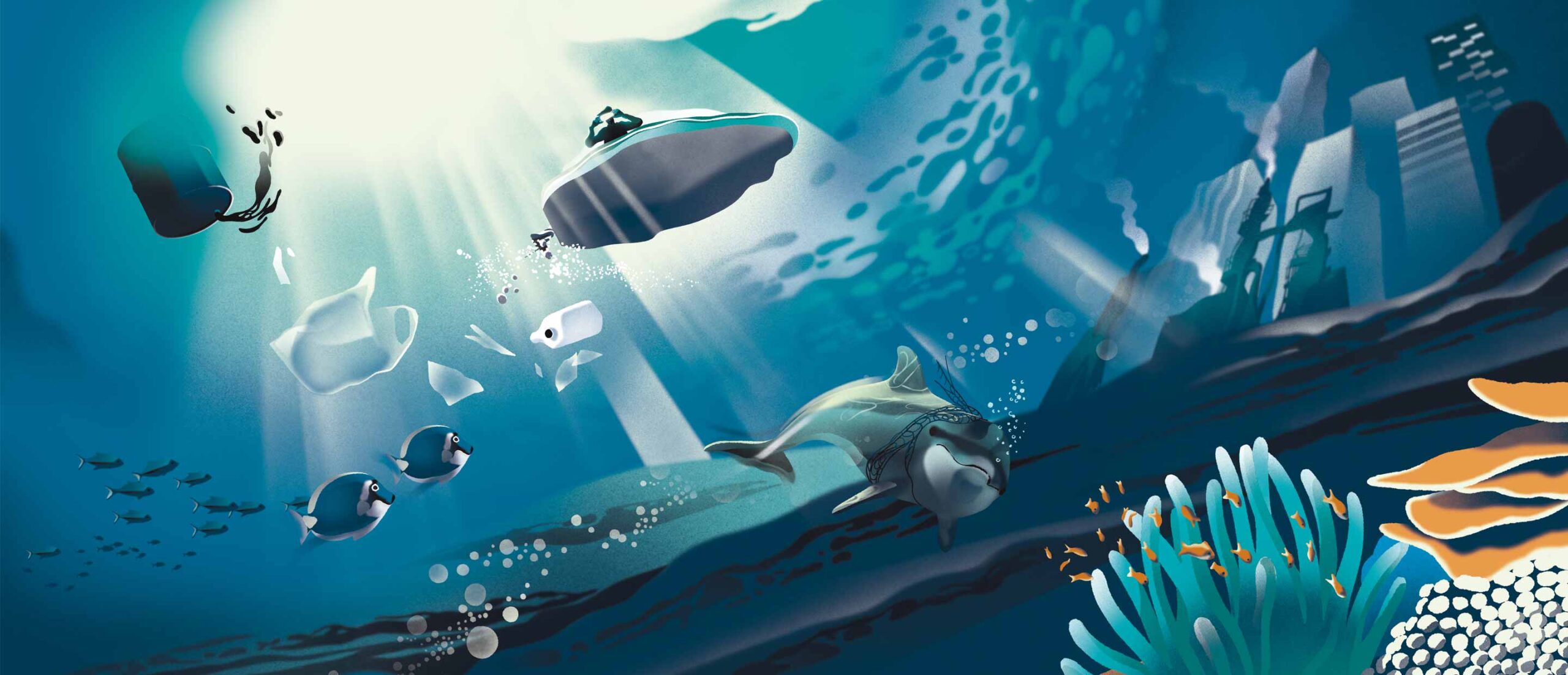Blue Economy is related to the UN’s Sustainable Development Goal 14, “Life Below Water”. The main objective of SDG 14 is “to conserve and sustainably use the world’s oceans, seas and marine resources for sustainable development”. India has a unique maritime location in the Indian Ocean. It has a coastline of more than 7500 km spread across nine coastal States, 12 major and 200 minor ports with over 2 million km² of Exclusive Economic Zone (EEC) available here, Approximately 95% of the country’s trade by volume and 68% by value are moved through Maritime transport and today India is one of the most exciting emerging markets in the world. Thus, India has a huge potential for the development of the Blue Economy. India is the second largest fish-producing country in the world and accounts for 7.58 percent of global production. It has been an important sector that provides food, nutrition, employment, income and livelihood in India. Above 70% of the people in India are non-vegetarian, while access to seafood is limited to the coastal areas. If the reach of this seafood is increased even in the interior parts of the country, then along with the growth of the seafood market in India, the blue economy will also increase. This will ensure food security along with increasing employment and will also help in the economic development of the country. For example, in Bihar (one of the States of India) about 75% of the population is carnivorous but produces or consumes only freshwater fish, but seafood is almost not available or used to supply in the State. The State’s one-third part remains under flood water, rainwater and water released by Nepal through rivers flowing towards India. Consequently, the rural population can not cultivate the land and is only dependent on food that grows with water. The hypothesis is that if the seafood market is brought to this region, then there is a lot of potential for the development of the blue economy in Bihar. It will not only help in economic development but will also help in generating employment and getting nutritious food. It can neutralise food scarcity due to water-logged situations. Thus, the domestic market can provide big access to fisheries, aquaculture and other ocean products in India and can be a source of sustainable development.
Introduction
Our blue planet, the Earth, contains a large maritime domain. The oceans cover approximately 72 percent of the earth’s surface. Over 600 million people (around 10 percent of the world’s population) live in coastal areas that are less than 10 meters above sea level. Nearly 2.4 billion people (about 40 percent of the world’s population) live within 100 km (60 miles) of the coast.[1] Oceans are central to life on Earth. They are rich in oil and natural resources, suppliers of oxygen, absorbers of CO2, a virtual heat sink and rich in biodiversity, and they have emerged as the global economic highways for the transit of trade. In the last few decades, human interference in the ocean has increased which affects the health of the ocean, marine habitat and climate such as Pollution of our ecosystems, plastics pollution, ocean acidification, overfishing, coral bleaching, sea temperature rise etc. Considering the importance of the ocean and preventing such a negative impact, a new paradigm “Blue Economy” emerged. The concept of the “Blue economy” was first introduced by Gunter Pauli in his book “The blue economy 10 Years 100 innovations hundred million jobs in 2010”. But the importance of the blue economy has been recognised at the United Nations
Conference on Sustainable Development (UNCSD) held in Rio de Janeiro in 2012 where the Blue economy was viewed as an ocean economy that aims at the “improvement of human well-being and social equity, while significantly reducing environmental risks and ecological scarcities”. Blue Economy is related to Sustainable Development Goal 14 “Life Below Water”. The main objective of SDG 14 is “to conserve and sustainably use the world’s oceans, seas and marine resources for sustainable development”. We are so close to 2030 and many of the SGD- 14 targets are still not met and we are not close enough. So, We have to adopt a cohesive and integrated approach to address climate and environmental challenges in both manners within a country and among countries.
India’s Blue Economy Scope
India has a unique maritime location in the Indian Ocean. It has a coastline of more than 7500 km spread across nine coastal States, 12 major and about 200 minor ports with over 2 million km² of Exclusive Economic Zone available here. (Figure 1&2) Approximately 95% of the country’s trade by volume and 68% by value is moved through Maritime transport.[2]
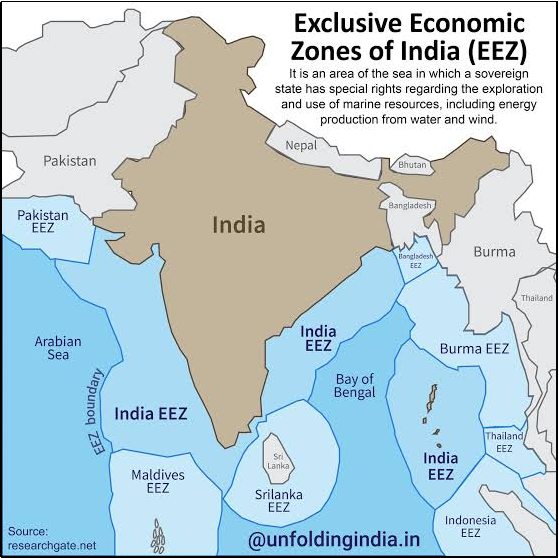
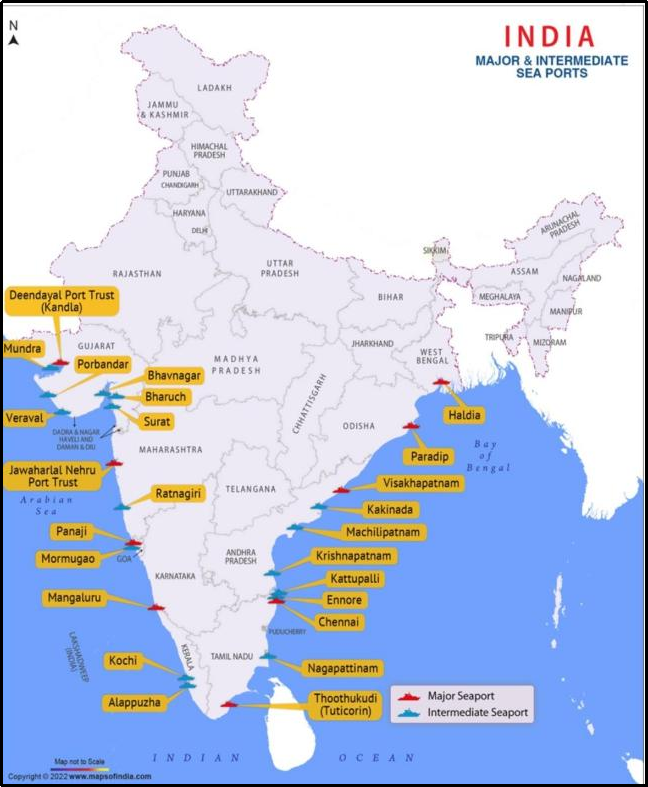
We are seeing that there is immense potential for the development of the Blue Economy and it can play an important role in the overall development of India but it seems that India is not exploring and exploiting its full potential in the development of the Blue Economy. India was among the first in the world to create a Department of Ocean Development in 1981, now the Ministry of Earth Sciences (MoES) but we do not progress as much as we should to be. However several countries have undertaken initiatives to utilise their blue economy. For instance, Australia, Brazil, the United Kingdom, the United States, Russia, and Norway have developed national ocean policies.
In sync with UN sustainable development, India needs to enhance its maritime capabilities and skills to increase employment and prosperity while making efficient and sustainable use of marine resources.
The Government of India’s Vision of New India by 2030 announced in February 2019 highlighted the Blue Economy as one of the ten core dimensions of growth. The Blue Economy was mentioned as the sixth dimension of this vision stressing the need for a coherent policy integrating different sectors so as to improve the lives of the coastal communities and accelerate development and employment.
The Government of India has published India’s Blue Economy: A Draft Policy Framework 2020. The draft Policy aim is to significantly enhance the contribution of the Blue Economy to India’s GDP, improve the lives of coastal communities, preserve our marine biodiversity and maintain the security of our marine areas and resources.[3] In this draft policy framework, seven priority areas are identified for the Blue Economy. In this article we will try to look at the prospects of the marine fish market in Bihar under Priority Area 3: Marine Fishery Aquaculture and Fish Processing.
Fisheries Sector in India
The fishery in India emerged as a sunrise sector that provides food, nutrition, employment, income and livelihood. India is the second largest fish-producing country in the world after China and accounts for 7.58 percent of global production. A total of 14.16 MMT of fish is produced during 2019-20 with a contribution of l0.44 MMT from the Inland sector and 3.78 MMT from the Marine sector.[4] (Figure 3) India produced 14% of Inland fish and 4% of marine fish of the world while China produces 16% of inland fish and 15% of marine fish.[5] So, it’s clear that India has tremendous potential in the fresh and marine fisheries sector. But if we look at the reach of the marine food market, it does not have access to the interior parts of India. The marine fish market is not available despite its potential in various states of India, although it is available in coastal states like Gujarat, Maharashtra, Goa, Kerala, Tamilnadu, Andhra Pradesh etc. Gujarat, Tamil Nadu and Andhra Pradesh together account for about 50% of the total Marine fish production in India.[6]
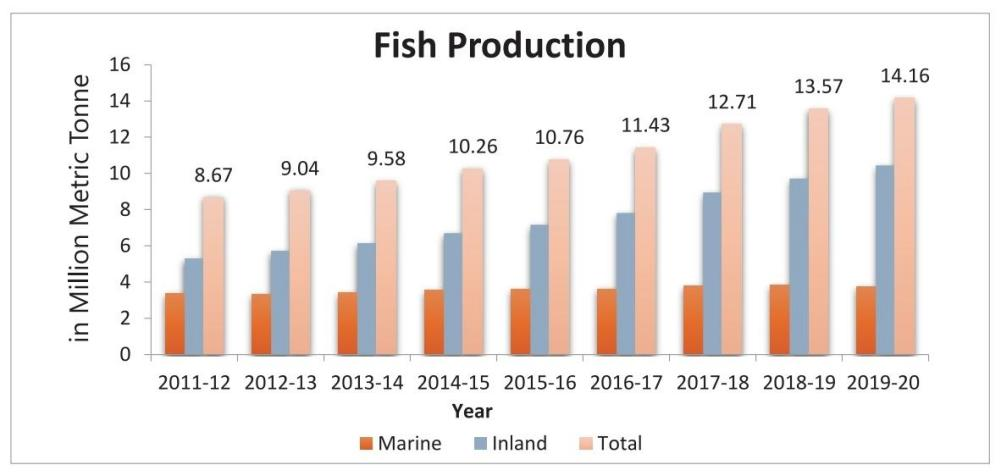
If we extend the reach of the seafood market to the remotest part of India, it will not only increase the fisheries sector status but will also contribute to the country’s economy. Through this paper, we will try to see the possibilities and prospects of the Marine food market in Bihar.
Fisheries Sector in Bihar
Bihar is a landlocked and agriculturally dominated State but Bihar is blessed with tremendous natural resources of freshwater. Many small and big rivers coming from the Himalayan region make Bihar rich in terms of freshwater resources. The Ganges is the main river here and the Ghaghara, Gandak, Budhi Gandak, Bagmati, Kosi and Mahananda are its main tributaries as we have mentioned above, National Waterway 1 is also being developed from Allahabad to Haldia which passes through the middle of Bihar. Bihar has about 3,200 hectares of rivers, 5,00,000 hectares of floodplain wetlands area, 9000 hectares of ox-bow lakes or mains, 25,000 hectares of reservoirs and 80,000 hectares of ponds and tanks.[7] (Fig. 4).
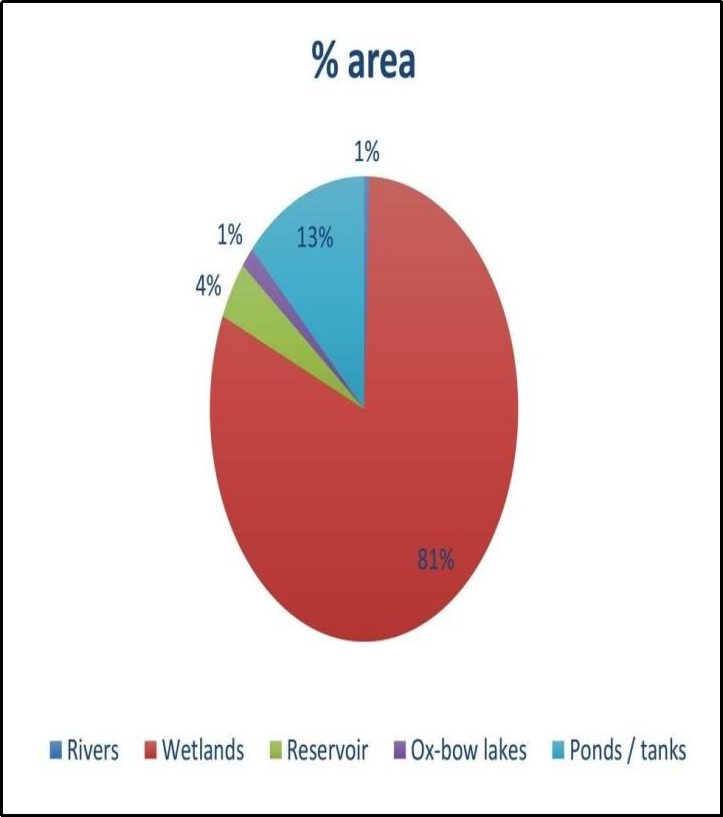
Due to being rich in such huge freshwater resources, the inland fish market is well-developed in Bihar. As per the Bihar Annual Budget 2019-20, Bihar produced 6.41 lakh tonnes of fresh fish during 2019-20. Bihar has a flourishing inland fish market but when it comes to the marine food market, it is neither produced nor marketed here. (Figure 5).

Possibilities of Fisheries and Aquaculture Market in Bihar
Bihar is seen as a poor, agricultural and backward state. Where there is no big industry. But as mentioned above, Bihar is naturally rich in freshwater fisheries. So there is immense potential for the development of fisheries, aquaculture and fish processing sector.
If we look in terms of consumer availability about 75% of the people in Bihar are non-vegetarian.[8] (Figure 6) People are fond of eating non-vegetarian food like fish, snails, crab, chicken and goat meat which are easily available here. Therefore it is highly likely that there will be a large number of consumers for the seafood market in the region. There are many such areas in Bihar where water remains stagnant for 5 to 6 months in a year, which affects the agricultural production there (Figure 7). In such areas, fish becomes a source of protein and a means of livelihood for people. But it only helps people to survive, it is not developed on a commercial scale. The seafood market can be developed on a commercial scale in these areas, which can provide job opportunities to the people of these areas.
As per the Bihar Annual Budget 2019-20, Bihar produced 6.41 lakh tonnes of fresh fish during 2019-20. While the estimated demand for fish is around 8.5 lakh tonnes.[9] To meet the demand for fish, fish is imported from Andhra Pradesh, West Bengal and Nepal. This demand gap can be met by promoting the seafood market. The share of fisheries and aquaculture in the Primary sector GSDP (Gross State Domestic Product) was about 8% in Bihar during 2019-20.[10] In such a situation the marine fish market can contribute significantly to meeting the fish needs of Bihar.
Figure 7. Water logged area of Bihar (a) Pre-Monsoon. (b) After Monsoon
Considering all these circumstances, it appears that if a seafood market is made available in Bihar, there is every possibility that there will be a large number of seafood consumers and the possibility to develop a huge market for marine food.
There has been a significant increase in the production of fish in Bihar especially after the Nitish government came to power, specifically after 2011, While the total production of fish was 2.99 lakh tonnes in 2011, it increased to 6.41 lakh tonnes in 2020.[11]
Bihar already has a large number of consumers of fish along with a huge inland fish market as mentioned above. Considering these facts, it appears that Bihar has immense potential to have seafood consumers and has immense potential for the growth of the seafood market.
Prospects
If the Government of Bihar takes concrete steps to promote the seafood market in the state, then it can prove beneficial for the 105 million people of Bihar. Fish is the largest and cheapest source of animal protein in a poor state like Bihar. The development of the seafood market in Bihar will not only help in economic growth but will also help in generating job opportunities, poverty eradication, getting nutritious food, and ensuring food security.
The fish industry currently contributes 8% to Bihar’s Primary Sector GSDP.[12] (Gross State Domestic Product). The seafood market will contribute to the growth of the GDP of Bihar as well as provide a huge employment opportunity thereby improving the quality of life.
There is a strong link between unemployment and migration in Bihar. People have to migrate to other places in search of work. The unemployment situation in Bihar is very bad. According to CMIE (Centre for Monitoring Indian Economy Pvt. Ltd.) Report 2021, Bihar had an unemployment rate of about 13%, while India’s unemployment rate was 7.7%.[13] The seafood market will prove to be helpful in reducing the number of people migrating in search of work along with providing employment opportunities to thousands of people of Bihar.
Bihar is the most flood-prone state of India, millions of people in Bihar are suffering from unemployment, poverty, and malnutrition. Marine food products will help in reducing poverty by providing nutritious food and increasing employment opportunities as well as boosting the economy of Bihar. According to NITI Ayog’s Multidimensional Poverty Index (MPI), Bihar has the most number of poor people in India with 51.91% of the population of Bihar being poor.[14] The fish industry in Bihar currently contributes 8% of Bihar’s primary sector GDP. The seafood market has the potential to improve the poverty index and contribute to the GDP of Bihar.
So clearly we can say that there is every possibility that if seafood market opportunities are opened in Bihar it will make a significant contribution to the development of Bihar which is seen as a poor agrarian State. There is every possibility that if seafood market opportunities are available here it will make a significant contribution to the development of Bihar which is seen as a poor, agrarian state. Therefore, The Bihar government will have to pay attention to Marine food market potentials, strategies for development, and creating sustainable livelihood opportunities for the people of Bihar.
Disclaimer: The views and opinions expressed by the author do not necessarily reflect the views of the Government of India and Defence Research and Studies
Image Courtesy: IORA
End Notes
[1] The Oceans Conference. (2017, June 5-9). UN.ORG.
https://www.un.org/sustainabledevelopment/wp-content/uploads/2017/05/Ocean-fact-sheet-package.pdf.
[2] M. (2020-21). Chapter -II, YEAR AT A GLANCE. MINISTRY OF PORTS, SHIPPING
& WATERWAYS.
https://shipmin.gov.in/sites/default/files/AnnualReport2021_0.pdf.pg.06
[3] Government Of India, E. A. C. (2020, September). India’s Blue Economy: A Draft Policy
Framework. GOI.
[4] Chapter-II, Status of Fisheries Sector In India, Department Of Fisheries Annual Report
2020-21. (n.d.). Department of Fisheries, GoI. https://dof.gov.in/. pg.11.
[5] Department of Fisheries ; Government of India. (2020). Handbook on Fisheries Statistics,
pg137.
[6] Department of Fisheries ; Government of India. (2020). Handbook on Fisheries Statistics,
pg6&8
[7] Chand, G. B., and Suday Prasad. “Present Status, Potentials and Future Prospects of
Fisheries Development in Bihar.” Environment and Ecology 39.1 (2021): 10-15.
[8] India today group, baseline survey 2014.
[9] Chapter-III, Agriculture and Allied Services, Bihar Economic Survey 2019-20,Govt. of
Bihar, pg.96.
[10] Chapter-III, Agriculture and Allied Services, Bihar Economic Survey 2019-20,Govt. of
Bihar, pg.96.
[11] https://www.ceicdata.com/en/india/fish-production/fish-production-bihar , Retrieved on
23 june 2022.
[12] Bihar Economic Survey 2019-20; agriculture and allied services pg96,135.
[13] Digital Article, unemployment for years, craving govt. job: Why story of Bihar’s youth
is of struggle & despair, The Print,10 feb 2022; Retrieve on 23 Jun 2022.
[14] Dash, N. (2021, November 25). 51.91% people in Bihar poor, highest in India: NITI Aayog Report. English. Retrieved July 20, 2022, from https://www.indiatvnews.com/news/india/poor-in-bihar-highest-in-india-niti-aayog-report-746666#:~:text=According%20to%20NITI%20Aayog’s%20Multidimensional,population%20of%20Bihar%20is%20poor.
References
[1] Chand, Gyanendra & Prasad, Suday. (2021). Present status, potentials and future prospects
of fisheries development in Bihar. 39. 10-15.
[2] Handbook on Fisheries Statistics, 2020. Government of India, Ministry of Agriculture,
Department of Animal Husbandry, Dairying & Fisheries, New Delhi.
[3] Kumar, R. S., Kumar, D. K., Prakash, S., Krishnan, M., & Ojha, S. N. Status of Small-Scale
Inland Fisheries in Bihar, India.(SSRG-IJEMS) – Volume 6 Issue 8– Aug 2019.
[4] Economic Advisory Council, 2020. India’s Blue Economy: A Draft Policy Framework. New
Delhi, Government of India.
[5] Thakur PK, Choudhary LK, Munshi JD. Fishery Economics of the Kosi River system (North
Bihar): Problems of marketing and its management, Ad. Fish Res. 2003; 3:1-28.
[6] Das BK, Chandra G, Kumari S, Meena DK, Kaushlesh SK, Baitha R, Trivedi RK (2019)
Roadmap for fisheries development in mauns and chaurs of Bihar. Policy Paper 6. Central
Inland Fisheries Research Institute, Kolkata.
[7] Narayanan, Sumana. “Inland fisheries, food security and poverty eradication: A case study of
Bihar and West Bengal.” (2016).
[8] Chandra, Ganesh, and B. K. Das. “Governance and institutional arrangement in floodplain
wetlands fisheries of India: comparative study of Assam and Bihar.” (2019).
[9] Ayyappan, S., and R. P. Raman. “STATUS OF FISHERIES DEVELOPMENT IN EI HAR:
CHALLENGES AND STRATEGIES IN THE 21ST.”(2003).
[10] Kumar, D., Mehta, R., Yadav, R., Kumar, S., & Kumar, M. (2018). Studies on fisheries status
and socio-economic conditions of fisher community in Dholi region, Muzaffarpur, Bihar, India. J
Entomol Zool Stud, 6(3), 76-80.

